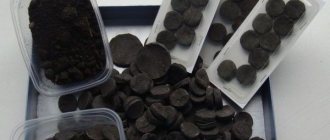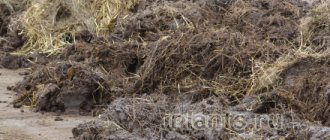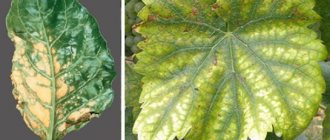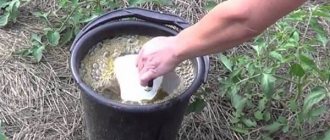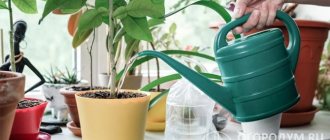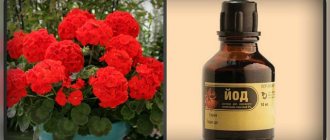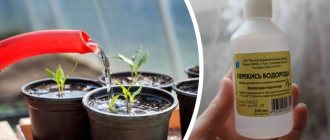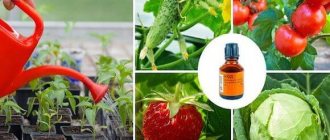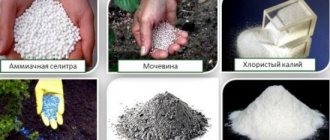Yeast feeding - as a fertilizer for plants
Yeasts are the simplest single-celled fungi. Their composition itself lacks nitrogen, phosphorus, potassium, that is, those important microelements necessary for normal plant growth. But once in the soil, they begin to affect the organic residues that are in the ground. They begin to process them, thereby decomposing these residues faster and better. When decomposed, they release large quantities of nitrogen and phosphorus into the soil.
Plants accordingly absorb the increased content of these elements and actively develop. Nitrogen helps build up vegetative mass, and phosphorus promotes better development of the root system. Here is the effect of their use. That is why such fertilizer is considered a growth stimulator. And it’s not for nothing that the following expression appeared: “It’s growing by leaps and bounds.”
How to use it correctly
Yeasts are considered to be single-celled fungi. They are divided into several types. Therefore, when using, you must remember: not all types of product will help you get a good harvest.
The frequency of applying yeast fertilizers should also be limited. Otherwise, instead of acquiring good fruits, the farmer will observe impoverishment of the soil.
Timing and frequency
Constant application of yeast fertilizers leads to problems with the soil. Hence an important rule for all gardeners with or without experience: infusions are used only 2-3 times during the season. And the first time - to improve the rooting of seedlings and seedlings.
How to use yeast to feed plants in the garden
Fertilizer has a lot of useful properties, namely:
- Stimulates vegetative growth of plants;
- Improves the soil, that is, enriches it with beneficial bacteria;
- The root system becomes more powerful;
- The endurance of plants improves and their immunity to adverse weather conditions increases;
- The survival rate of any seedlings improves.
Yeast requires warm temperatures for normal functioning. Therefore, fertilizing is used on warm days when the soil is sufficiently warm. If the air temperature decreases, the ground temperature also decreases accordingly, just like in rainy weather. Beneficial mushrooms will not work in such an environment, so the use of fertilizer in such weather conditions will be completely useless. But on warm, hot days, feeding warm soil will be just the thing.
And one more important point. Keep in mind that potassium and calcium must be added to the soil. Because when yeast is added, these elements are absorbed from the soil. As a result, the plant will lack these elements. And the simplest remedy that will help compensate for the loss of these elements is wood ash, since it contains both potassium and calcium.
Trembling is a growth stimulator
For all homeowners who have a vegetable garden, the most important thing is to grow a good harvest of vegetables. As soon as spring chores begin in the garden, vegetable growers stock up on fertilizers and anti-pest medications.
In recent years, yeast has become the most popular fertilizer. What does feeding with this culinary product give? Yeast is enriched with a number of vitamins, proteins and microelements. And when they get into the soil, they suppress unnecessary bacteria and create a suitable environment for beneficial microorganisms. They also speed up metabolic processes, which is beneficial for rapid plant growth. They are believed to be especially useful for seedlings.
Seedlings fertilized with a nutritional supplement begin to grow green mass and form a strong root system. Fed in this way, it tolerates picking better, and then takes root faster when transferred to the ground.
What happens in the spring with fed transplanted seedlings:
- The growing season is shortened and growth accelerates.
- Seedlings tolerate weather changes more easily, especially cold weather.
- The immune system is strengthened, making plants better able to resist various diseases.
- In strong plants, flowers set faster, then the ovaries form more easily.
- The taste of the fruit becomes richer.
How to prepare yeast nutrition
Anyone can prepare fertilizer for plants using yeast, since the process is simple and inexpensive. You can use not only raw yeast, but also the product in the form of a dry powder. Summer residents prefer to prepare fertilizer in the form of a liquid solution, because this form of fertilizing is easier to apply to the soil. We invite you to familiarize yourself with the most popular recipes for yeast fertilizer.
From dry concentrate
Yeast nutrition can be prepared from any concentrate that is sold in a regular grocery store. You will need to mix 100 grams of yeast powder and 2 tablespoons of regular sugar. All this should be combined with water (10 liters). After this, you need to leave the solution to brew for 2-3 hours so that the yeast is completely dissolved in the liquid. And now the finished starter should be diluted again in 50 liters of water. Feeding for flowers and seedlings is ready.
There is a simpler method of preparing a solution for feeding plants with yeast. You just need to dilute one tablespoon of dry concentrate in one bucket of water and let it brew. This fertilizer is much weaker than the previous one, but at the same time it is more gentle on plants. Sugar in such recipes is a kind of catalyst and it is this that enhances the overall effect of such a solution.
From raw
Many summer residents also use another recipe, for which you need to take only 100 g of raw yeast. This volume must be added to a bucket of water and stirred thoroughly. The water must be warm, but this fertilizer must be allowed to brew for 24 hours before use.
What it is
Yeast is a single-celled, sugar-eating fungus that is egg-shaped and can only be seen under a microscope. One cell can divide two and a half dozen times.
To make the fertilizer, ordinary baker's yeast is used - both dry and fresh.
- The active powder looks like small light or dark beige granules (they may look like sticks or balls). Packaging can be different - 15, 25 or 100 g.
- Compressed yeast resembles small bricks. There are both fifty and one hundred gram packs on sale. The color of the dense mass can be milky or cream. The consistency is somewhat reminiscent of plasticine, but when broken, it does not spread across your fingers, but crumbles or splits.
It is very important to store the product correctly. After opening the package, dry powder can be stored in the refrigerator for about 7 months, fresh yeast - no more than 28 days. In addition, the compressed product deteriorates without access to air, so it is not recommended to store it in a tightly tied bag.
What plants can be fertilized with yeast?
Mostly, gardeners use yeast mixtures to saturate the soil when growing:
- tomatoes, cucumbers, peppers, carrots, radishes;
- Strawberry wild-strawberry;
- garden petunia;
- indoor geranium.
The application of fertilizers, even with such excellent properties as yeast, should be treated with caution. A single formula for care and cultivation does not work for all plants.
Do not saturate the soil with this component if it grows: onions, potatoes, garlic. If this important nuance is not taken into account, the crop will be unsuitable for long-term storage.
Below is a table with the preparation standards and rules for using this product for the most popular cultivated plants.
| Vegetable crop | Preparation and application of fertilizer |
| Tomatoes | Dissolve 100 grams of the dry variety (10 sachets) and 2 tablespoons of sugar in a ten-liter container with warm water. Let it ferment for no more than a couple of hours. Mix the stock solution 1 to 5 with clean water. Consumption rate – 500 ml per 1 bush. Apply three times: after transplanting seedlings into the ground, after rooting and before flowering |
| cucumbers | Dilute 10 grams of dry yeast in a liter of water, add an additional 50 grams of sugar. Leave for a couple of hours. Add another 9 liters of water. Let it brew for a few more hours. Dilute 1 to 5 and feed the plants |
| Eggplant | Mix 100 grams of yeast, 10 liters of water, half a liter of ash infusion, the same amount of chicken manure infusion and 3 tablespoons of sugar. Consumption rate – 2 l per 1 bush |
| Strawberry | Mix 1 kg of fresh product in 5 liters of water. Insist for a day. The standard for preparing the working solution is: 0.5 liters of starter per 7 liters of water. Consumption rate – 0.5 l per 1 plant |
| Peppers | Mix 5 liters of water, 50 grams of fresh yeast, 250 ml of chicken manure infusion, 250 ml of ash infusion and 2 tablespoons of sugar. The solution is enough for 3 plants |
| Cabbage | Mix 3 liters of water, a packet of baker's yeast from the grocery store and 100 grams of granulated sugar. Leave for 5-7 days. To prepare the working solution, mix a glass of the resulting dough and 10 liters of water. Fertilize three times throughout the entire season. |
The first assistant in the absorption of nutrients is succinic acid
Succinic acid helps plants quickly adapt to new conditions that arise as a result, for example, of transplanting to another place, and also promotes the absorption of nutrients from the soil after feeding it.
If we are talking about seedlings, then it will be effective to soak vegetable seeds in a solution of succinic acid, this will increase their resistance to most possible diseases. Subsequently, water the sprouted sprouts with the same solution and spray the formed leaves. This substance destroys toxins in the soil, preventing them from penetrating into the plant itself. By increasing chlorophyll, which is promoted by succinic acid, the yield of vegetable crops increases significantly.
To achieve the result you want, it is very important to maintain the correct proportions and dosage of the substance during the preparation process. So,
- for spraying plants: 1 tablet of succinic acid is diluted in a glass of warm water until dissolved, and then the resulting liquid is poured into a liter of water at room temperature. Spraying the plant is used to stimulate the development of new leaves and shoots - once every 3-4 weeks;
- for soaking seeds before sowing: the solution is prepared in the same way, the seeds are soaked for about 20 hours, after which they are dried at room temperature and sowing begins;
- to soak the roots before replanting the plant: dissolve 1 tablet in a glass of warm water and pour the resulting solution into water at room temperature, bringing the total volume to a liter. Soaking time 1.5 - 2 hours.
Succinic acid in tablet form should be stored in a dry, shaded place where the air temperature does not exceed +25 degrees. When diluted, the shelf life is 15-20 hours. The substance is safe for humans and animals, but despite this, it is recommended to store it away from food.
How often to water with yeast nutrition
Yeast feeding is carried out 2 times per season, no more, and only in the early stages of plant growth. It is during this period that such fertilizer is very necessary for development and will be beneficial.
The first application is carried out after the seedlings have been planted in a permanent place, and they have taken root and started to grow. During this period, seedlings for further growth urgently need nitrogen and phosphorus to build a powerful root system. It has been noticed that this helps to grow the root system 2 times more than without it or when using other fertilizers. The plants themselves look stronger because they absorb increased nitrogen content from the soil, microelements, and organic iron. And such plants will be much stronger and healthier.
The second application is carried out after 2 weeks. It would be enough. Further use will no longer be effective, since during the fruiting period phosphorus and potassium are needed more than nitrogen. The main thing here is not to overdo it, otherwise such fertilizing will give lush greenery.
Before applying fertilizer, the plants are first watered with water. The earthen lump should be moist so that the nutrients are better absorbed by the roots.
How to feed young seedlings
As soon as the time for picking tomatoes approaches, it’s worth thinking about the first yeast feeding. After picking, fertilize after 10 days. This will allow the young seedlings to quickly grow stronger and begin to grow green foliage.
2 weeks after planting in a greenhouse or soil, you can water again. This will allow the plants to take root well in their new location. The use of such fertilizer will slow down the development of fungi, protect cucumbers from gray rot, and tomatoes from late blight.
The third feeding is carried out during the period when the buds begin to appear. Watering with yeast will help vegetable crops to bloom profusely, and then also abundantly reward their owners with delicious fruits.
Vegetable growers notice that after this addition, cucumbers produce less empty flowers, and the fruits grow strong, without empty spaces. If you notice that the borage is developing poorly, then add a solution with a culinary product to enhance the development and productivity of the plants.
But this useful supplement has one dangerous property. By releasing a lot of useful things into the soil, it absorbs all the potassium and calcium from the soil. It would seem that they have applied fertilizer, but the leaves of the seedlings begin to curl, dry out, and then fall off (instead of a harvest, the gardener gets a sad experience).
Important ! Yeast can only be used together with potassium fertilizers, and calcium must also be supplied with them.
To replenish these elements, some gardeners add wood ash (200 g/m2) and eggshell powder (50 g/m2) along with the yeast solution. You can use this option: before fertilizing, add potassium sulfate and calcium nitrate to the soil.
Yeast dressing recipes
Let's look at the most interesting, in our opinion, recipes for nutrient mixtures for plants.
Standard recipe for seedlings
Dissolve 200 grams of fresh yeast in a liter of warm water. Leave the mixture to steep for 3-4 hours. Mix the resulting mother solution with water 1 to 10 and water the seedlings.
Pepper seedling mixture
Take a pack of fresh yeast weighing 100 grams and stir it in a bucket of very warm water. Cover with a lid and leave to ferment for 24 hours. After this, water the pepper seedlings.
In general, 10 liters of prepared mixture can be a lot. Therefore, prepare smaller amounts of fertilizer. For example, 30 grams per 3 liters of water.
“Tasty solution” of yeast with sugar
To make the mixture ferment better, sugar is added to it. Mix a packet of dry yeast completely in a bucket of water. Next, add 2 tablespoons of sugar and let the solution ferment for a couple of hours.
The result is a mother solution. To prepare a working solution, add 500 ml of water for every 100 ml of mother solution.
Top dressing with ash
Prepare yeast fertilizer: 100 grams of fresh product per 1 bucket of water. After this, add 0.5 liters of ash solution, 2 balls of ascorbic acid and 100 grams of sugar. The resulting mixture is infused for a day. To prepare the working solution, the resulting concentrate is mixed 1 to 10 with clean water.
Nutritional mixture with whey
Add a packet of dry yeast per liter of milk or whey. Leave to ferment for 2 hours. Then bring the volume of liquid to 5 liters (fill in 4 liters of water) and add a kilogram of crackers. The mixture is left to ferment for a week and stirred occasionally.
The working solution is prepared in the ratio of 200 ml of concentrate per 5 liters of water.
Nettle solution
This recipe is for a 70 liter container. Fill it with chopped nettles. Add half a kilo of breadcrumbs. Then add 500 grams of live yeast, 3-4 tablespoons of sugar or jam. Next, fill the water to the brim and leave it to ferment for a day.
Vitamin mixture
Recipe for 40 l. If you need less fertilizer, then reduce the amount of all components several times.
So, for 40 liters of water you need 0.4 kg of fresh yeast, 0.3 kg of ash, 2 kg of manure, a bucket of nettles or other greens.
Mix everything and leave to ferment for 15 days. Next, strain the liquid and mix it with clean water in a ratio of 1 to 10 to prepare a working solution. The liquid consumption rate is 1 liter per 1 bush (tomatoes, tomatoes, peppers, cucumbers) or 1 sq m of planting.
Infusion with potato tops
Pour half a kilo of potato tops into 5 liters of water, break and stir 100 grams of fresh yeast. Leave for 4 hours. Strain and use for foliar treatment of plants.
Iodine mixture for spraying
Mix 3 liters of whey, 100 grams of live yeast and leave to ferment for 5-6 hours. Bring the volume of liquid to 10 liters. Pour in 20 drops of iodine. Mix and spray as a prophylactic against late blight.
Solution with droppings and ash
Add 10 grams of dry product, 5 tablespoons of sugar, half a kilo of ash and droppings to 10 liters of water. Mix and leave to ferment for 3 hours. Dilute 1 to 10 to obtain ready-made fertilizer. Water the rows.
Features of fertilizing with yeast in autumn, summer, spring of different crops
Fertilizing with dry or fresh yeast is useful for many garden inhabitants. But there are crops that are harmed by such fertilizing. These are potatoes, garlic, legumes, onions. The use of yeast has a bad effect on the taste, makes it watery and shortens the shelf life.
- Fertilizing cucumbers with yeast is carried out twice during the entire growing season: the first time it is better to use the recipe with nettle foliage, the second time with ash. You need to use at least a liter per copy. Fertilizing cucumbers with yeast is very necessary for seedlings that need nutrition. This increases its chances of survival even in low light conditions.
- Peppers, root vegetables - beets and carrots - also respond well to yeast feeding with the addition of ash.
- You can also fertilize strawberries with yeast. One bush will require 500 ml of liquid. The first feeding is necessary at the end of April or beginning of May (it all depends on the weather). This will help stimulate the berry to bloom early and grow quickly. Repeat - only when green berries appear (no need to feed during flowering). The third time you can feed after harvesting.
- Feeding tomatoes with yeast is done using milk or whey. Experienced gardeners recommend adding about two dozen more drops of iodine. The consumption is the same - no less than a liter per bush.
- Under berry bushes you need to pour from 1 to 5 buckets of fertilizer (depending on size and age). If there is too much mixture, you can safely use it for foliar feeding, but only in calm and cloudy weather.
Fertilizing indoor plants with yeast is often used. Green pets often suffer from a lack of vitamins and minerals, which is manifested by lethargic leaves and falling buds. The main reason for this condition is the depletion of soil composition, because plants have to exist in limited conditions. Even large and deep pots do not help, so green pets need to be fertilized more often than garden flowers. In this case, it is worth using an effective resuscitating agent - yeast.
The dosage is the same, only you can reduce the amount of ingredients depending on the size of the flowerpots. It is better to fertilize monthly in autumn and winter and once every 10 days in spring and summer. The result becomes noticeable almost immediately. Green pets acquire a rich color, bloom more profusely and feel much better. The plant can get stronger and return to its normal state already on the fourth or fifth day after the first dose of the “medicine”.
Fertilizing flowers with yeast is used primarily to ensure their growth, development and flowering. This is the difference from vegetables, berries and other fruit crops, which require fertilizer for abundant fruiting.
Fertilizing indoor and garden flowers with yeast
Flowers, regardless of the conditions, also respond well and gratefully to the yeast saturation of the soil. The product is quickly prepared and does not require special expenses. These mixtures are used to fertilize violets, geraniums, orchids, roses, and petunias.
Usually a simple composition is used:
- Dry yeast (1 g), combine with sugar (1 tsp), heated water (1 l). After mixing the ingredients, set the container aside for several hours. The working solution is used for dilution with water 1:5 and watering plants.
- Fresh yeast (1 kg), combine with water (5 l), the resulting solution is added to 10 l of water. A good composition for feeding garden flowers.
Why yeast has a beneficial effect on seedlings
- Yeasts are living organisms that are single-celled fungi. Due to their high protein content, they influence the qualitative restructuring of the soil, which leads to increased plant development.
- Yeast contains a full range of minerals. They contain potassium and phosphorus in large quantities, and magnesium, iron, calcium and sodium in lower concentrations.
- Once in a warm environment (in the soil), the yeast begins to actively divide. One cell divides 25 times. Considering that the main waste product of unicellular fungi is carbon dioxide, the growth of colonies creates a nutrient medium for plants.
- Fertilizer is not so much the yeast itself as the products of its vital activity. Single-celled fungi stimulate the rapid decomposition of organic matter in the soil.
Fertilizer of berry crops and trees
To get good strawberry harvests, it is advisable to use yeast bait three times a season: at the first signs of bud formation; at the beginning of berry ripening; after the bushes finish bearing fruit - in the fall.
To prepare an effective fertilizer, take dry yeast (100 g), combine with heated water (5 l), and leave for 24 hours. 0.5 l of the resulting concentrate is diluted in water (10 l).
For the full development of currant bushes and excellent fruiting, prepare the following composition:
Dry substance (1 packet), dissolve in warm water (1 bucket - 10 l), add sugar (0.5 cups). Before adding the bushes, the concentrate is diluted with water in a ratio of 1:5.
When fertilizing cucumbers, it is worth remembering about grape seedlings, since the solution is ideal for both crops.
Properties and features of the use of yeast as fertilizers
The properties of yeast starter used for baking baked goods are known to bakers, cooks and many housewives. The product is used for preparing various types of baked goods: bread, buns, pancakes and pies. Thanks to the special properties of active microorganisms, yeast dough increases in volume, becomes light and is saturated with oxygen and carbon dioxide. When used in the garden, the product exhibits similar properties, having a beneficial effect on plants and soil.
On a note. According to reviews, the effect of the yeast solution becomes noticeable 10-12 days after the first use. Plants begin to grow more actively, the number of shoots increases, and the root system strengthens.
What properties and characteristics do yeast exhibit as fertilizers?
Feeding plants with yeast is as follows:
- the product is diluted according to one of the suitable recipes;
- on a warm day, water certain types of plants;
- under the influence of environmental temperature, yeast microorganisms begin to manifest their properties, affecting the soil (they process organic matter, releasing nitrogen, auxin, thiamine, and B vitamins during their activity);
- Plants receive useful substances through the root system, cell growth increases, and their immunity increases.
Important! Yeast is used in the form of an aqueous solution, and not in a concentrated state. They are not suitable for all types of plants.
Yeast fertilizers have a positive effect on indoor and vegetable crops as follows:
- roots grow faster, the number of lateral segments increases;
- seedlings take root better when transplanted;
- cuttings actively build up the root system and grow faster;
- the soil becomes more nutritious, saturated with nitrogen and potassium;
- the resistance of vegetables and flowers to the effects of adverse factors and diseases increases;
- tomatoes tolerate the picking procedure better and do not stretch in greenhouse conditions.
What yeast is best to use?
For feeding indoor plants, garden and vegetable crops, it is advisable to use an unexpired product. In this case, the number of active organisms is sufficient to obtain a positive effect.
Various types of yeast are suitable:
- alcohol (raw in briquettes);
- beer (live and euthanized);
- dehydrated (in the form of granules).
How to make a solution correctly?
The preparation method depends on the type of product. It is important to comply with several conditions:
- provide a warm environment;
- provide nutrition for yeast;
- wait some time necessary for the activation of microorganisms.
Fertilizers are prepared from dry yeast according to the following scheme:
- A small package weighing 10 g is diluted in warm water.
- For every gram of granules you need to use 1 liter of water, that is, to dissolve 1 sachet, you will need 10 liters of water.
- Granulated sugar is added to the resulting mixture to activate the organisms.
- After stirring the composition, the container is placed in a warm place for fermentation for several hours.
Important! The fermented composition is not used in its pure form. Each recipe contains instructions on how to dilute the composition before watering.
Raw briquettes are diluted in water according to the following scheme:
- the bucket is filled with water at 37-39 °C at the rate of 3.5 liters per 100 g of raw yeast;
- if the briquette is frozen, it is first defrosted at room temperature; if it has the consistency of plasticine, then it is immediately ready for use;
- crush the yeast with your fingers and mix with water;
- add sugar and put it in a warm room for a couple of hours;
- Before preparing the yeast feed, it is diluted with water in accordance with the recipe.
Tips and tricks
Experts give a number of recommendations that gardeners and gardeners, as well as those who like to grow house flowers on an indoor windowsill, should adhere to:
- You must always remember that yeast works in warm temperatures, and therefore it is important to apply yeast-based fertilizers to warm soil;
- The product, whether raw or powdered, must always be fresh. Expired yeast cannot be used to fertilize any plants;
- You need to adhere to the recommended amount of fertilizing plants with yeast per season. Don’t overdo it, because “more” does not always equal “better”.
- It is best to combine yeast fertilization of the soil with the addition of ash. This is especially true for garden crops. Ash replenishes the deficiency of potassium and calcium that has arisen in the soil, since the latter are absorbed by yeast during fermentation.
Advantages and disadvantages of this method
Both novice gardeners and experienced gardeners love to use yeast-based fertilizers. Advantages of the method:
- versatility (can be used for many vegetables, flowers, indoor plants, berries, shrubs);
- ease of preparation (a minimum of ingredients is used, little work (it takes a few minutes) - measure the amount of components, mix and let it brew);
- naturalness (all components are natural, not synthetic);
- safety (does not pose a risk to human health, animals, birds, insects);
- availability (the main component can be bought at any grocery store);
- cheap (a pack of yeast is quite inexpensive).
Yeast fungi are quite resilient; they are not immediately washed out when it rains. But there are some drawbacks, although compared to the advantages they are almost insignificant:
- short shelf life of the prepared mixture;
- risk of lack of calcium and potassium in the soil;
- the need to wait for the optimal air temperature.
The negative impact of fertilizing on plants is always associated with a frivolous attitude to the recommendations, exceeding the dosage or too frequent use.
Plant Compatibility
Despite the overall positive effect, yeast feeding will not be useful for all plants.
Compatibility:
- tomatoes;
- pepper;
- zucchini;
- cucumbers;
- carrot;
- radish;
- strawberry;
- chrysanthemums;
- petunia;
- peonies.
They don't like yeast:
- garlic;
- onion;
- potato;
- peas;
- beans;
- Saintpaulia.
